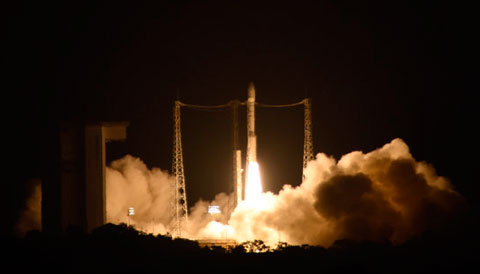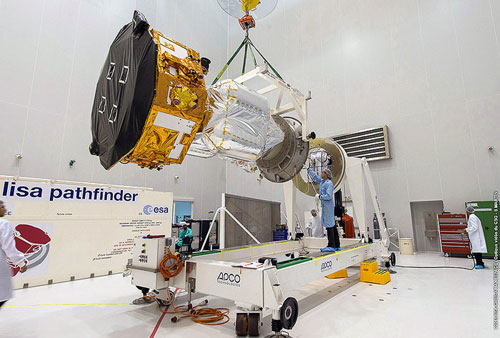LISA Pathfinder Heads to Space
An exciting new mission takes the hunt for gravitational waves into space.

The LISA Pathfinder launched earlier today at 5:04 UT. Watch the recorded launch here.
Stephanie Corvaja / ESA
Stephanie Corvaja / ESA
A trailblazing mission took to the skies early this morning as a Vega rocket carrying the LISA Pathfinder lit up the night over Kourou, French Guiana.
Originally known as the Small Missions for Advanced Research in Technology (SMART 2) and a forerunner to the full-fledged Evolved Laser Interferometer Space Antenna (eLISA) project, LISA Pathfinder will test the technologies key to conducting long-baseline laser interferometry in space. Coming almost exactly 100 years after Einstein proposed his theory of general relativity, this mission will prove vital in the hunt for one of the theory’s more bizarre predictions: gravitational waves.
The equations of general relativity say that accelerating massive objects, such as exploding stars or a pair of whirling black holes, ought to send ripples through spacetime. There’s solid indirect evidence that gravitational waves exist, but direct detection has eluded scientists so far.
LISA Pathfinder paves the way for eLISA, which will take that hunt into space. Slated for launch in 2034, eLISA will use three free-flying spacecraft to create a triangular baseline a million kilometers on a side — a feat impossible on Earth.
Lasers will measure the position of two masses suspended at the end of each arm, and then researchers will analyze the data to look for the very slight jiggling induced by gravitational waves passing by. The unique setup and location will give eLISA an unprecedented sensitivity .
But its setup is also tricky, posing several engineering challenges. To reduce the risk, LISA Pathfinder serves as a testbed for these new technologies, basically mimicking one arm of the future eLISA triplet.
LISA’s Mission

A diagram of LISA Pathfinder's journey to the Sun-Earth L1 Lagrangian point. (Click image for larger version)
ESA / ATG Medialab
ESA / ATG Medialab
The Vega rocket initially placed LISA Pathfinder in an elliptical orbit around Earth. Then with a series of engine burns, the spacecraft will spend eight weeks journeying to an operational Lissajous or halo orbit, circling around a stable Lagrangian point (L1) 1.5 million kilometers sunward of Earth.
The mission is designed to last only 180 days, during which LISA Pathfinder will perform a miniaturized test of so-called "precision metrology," the fine measurements vital to detecting gravitational waves.
The spacecraft carries two 46-mm-wide gold-platinum masses suspended in separate vacuum compartments and separated by 38 cm (scaled down from eLISA’s eventual 1,000,000-km-long baseline). Researchers aim to detect relative motion between the two masses with an accuracy down to 10 picometers, or 10 times a million-millionth of a meter.

Two masses (gold cubes) are suspended on either side of the science package aboard LISA Pathfinder.
ESA / ATG Medialab
ESA / ATG Medialab
In addition, LISA Pathfinder will test propulsion, laser ranging, and gravitational sensors built for the full-up eLISA mission. The mission will also demonstrate the first use of a micro-newton electric propulsion system.
LISA/eLISA aren’t the only gravitational wave observatories. Ground-based LIGO, recently refurbished as advanced LIGO, continues to pursue the same from the ground.
“LIGO and eLISA will complement each other,” says Amber Stuver (LIGO Livingston Observatory). “Comparing the frequencies that each are sensitive to, LIGO will be the treble clef and eLISA the bass.”
That is, while LISA measures gravitational waves in the millihertz range, detecting supermassive black hole pairs or binary white dwarfs, aLIGO is going after higher frequencies, looking for gravitational waves from supernovae and spinning neutron stars.
“The difference between space-based and ground-based detectors comes from the much longer interferometric arm lengths possible in space,” says Benjamin Knispel (Max Planck Institute for Gravitational Physics). In addition, space provides a gravitationally “quieter” environment than Earth — there’s no seismic activity, for example — so spacecraft can probe the lower frequencies.
To Launch and Beyond
The idea of a space-based laser interferometer capable of detecting gravitational waves has followed a rocky road to launch. Initially proposed as a joint mission between NASA and the European Space Agency (ESA), NASA had to pull out of the project in 2011 citing lack of funds.
The idea was reborn as the Evolved LISA project under the auspices of ESA.
“When you build a spacecraft for the first time, you have to learn how to build it,” says Shane Larson (Northwestern University), who worked on the early stages of LISA when NASA was still involved. “The most important thing to be learned from LISA Pathfinder has already been learned — how to put together a LISA-style spacecraft!”
Though LISA Pathfinder's mission is only slated to last about half a year, a proposed extension would call for the spacecraft to test general relativity under conditions of extremely low gravitational accelerations, as it threads an area known as the L1 'saddle point' where the gravitational pull of the Earth and Sun cancel out.
LISA Pathfinder will pioneer technology for the most ambitious space mission yet: eLISA’s full-scale, gravitational-wave observatory, which will open a new window on the universe.
Watch the recorded launch:

No comments:
Post a Comment